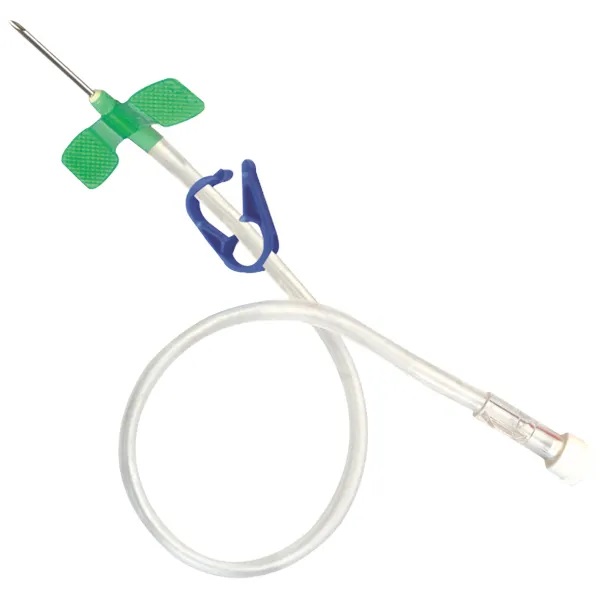Arteriovenous (AV) fistula needles play a crucial role in hemodialysis, a life-sustaining treatment for patients with kidney failure. These needles are used to access a patient’s bloodstream through an AV fistula, a surgically created connection between an artery and a vein, allowing for efficient blood flow during dialysis. This article will explore the application, advantages, sizes, and types of AV fistula needles to provide a comprehensive overview of this essential medical device.
Application of AV Fistula Needles in Hemodialysis
An AV fistula needle is specifically designed for patients undergoing hemodialysis. The AV fistula, created in the patient’s arm, serves as a long-term access point for the dialysis procedure. During hemodialysis, the AV fistula needle is inserted into the fistula, allowing blood to flow out of the body into the dialysis machine, where it is filtered and returned to the patient.
This needle’s primary function is to provide efficient and reliable vascular access to allow for optimal blood flow, which is crucial for the dialysis process to remove toxins and excess fluids from the blood effectively. The insertion of the AV fistula needle requires precision and care, as incorrect placement can result in complications, such as infiltration (when the needle enters a blood vessel wall), bleeding, or infection.
Advantages of AV Fistula Needles
AV fistula needles offer several advantages in the context of hemodialysis, especially when used with properly created and maintained fistulas. Some key benefits include:
1. Reliable Access to Blood Flow: AV fistula needles are designed to provide stable, long-term vascular access. The fistula allows for high blood flow rates, which is essential for effective dialysis. Using these needles ensures proper access to the bloodstream and helps maintain the quality of the dialysis session.
2. Reduced Risk of Infection: Compared to central venous catheters (CVCs) used for dialysis, AV fistula needles pose a lower risk of infection. Since the AV fistula is created from the patient’s blood vessels, the risk of infections like bacteremia is significantly reduced.
3. Increased Durability: The AV fistula itself is a more durable and long-lasting form of vascular access than other methods, such as synthetic grafts or CVCs. Paired with well-designed AV fistula needles, this access method can be used for years, reducing the need for repeated surgical procedures.
4. Improved Blood Flow Rates: AV fistula needles, combined with a healthy fistula, allow for better blood flow during dialysis. This improves the efficiency of the dialysis process, leading to better clearance of toxins from the blood.
5. Reduced Clotting Risk: Since the AV fistula is a natural connection between an artery and a vein, it has a lower risk of clotting compared to synthetic alternatives. AV fistula needles can be used consistently without the frequent complications associated with other access methods.
AV fistula needles come in various sizes, usually measured by gauge, which determines the needle’s diameter. The most common sizes used in hemodialysis include 14G, 15G, 16G and 17G.
How to choose the needle sizes of AV Fistula Needle?
| Reconmmended needle gauge | Blood flow rate | Color |
| 17G | <300ml/min | Pink |
| 16G | 300-350ml/min | Green |
| 15G | 350-450ml/min | Yellow |
| 14G | >450ml/min | Purple |
How to choose the needle lengths of AV Fistula Needle?
| Reconmmended needle lengths | Deep from the skin surface |
| 3/4″ and 3/5″ | <0.4cm below the skin surface |
| 1″ | 0.4-1cm from the skin surface |
| 1 1/4″ | >1cm from the skin surface |
Types of AV Fistula Needles
Several types of AV fistula needles are available, designed to meet the varied needs of dialysis patients. The types can differ in design and features, including safety mechanisms and ease of insertion.
1. Based on Material
AVF needles are typically made from two main materials: metal and plastic.
a) Metal Needles: Metal AVF needles are the most commonly used in hemodialysis. There are two types of metal needles based on the cannulation technique:
Sharp Needles: Edge is sharp, used in rope ladder cannulation.
Blunt Needles: Edge is round, used in button hole cannulation.
b) Plastic needles: Used for deep vein.
2. Based on Safety Features
AVF needles are also classified based on the presence of safety mechanisms, which are designed to protect both patients and healthcare workers from accidental injuries or contamination. There are two key types:
Disposable AVF Needles: These are standard AVF needles without any additional safety features.
Safety AVF Needles: Designed with built-in safety mechanisms, safety AVF needles are equipped to automatically shield or retract the needle after use.
Conclusion
AV fistula needles are a vital part of the hemodialysis process, offering reliable vascular access to patients requiring treatment for kidney failure. Their application in hemodialysis ensures efficient blood flow, leading to optimal dialysis outcomes. With various sizes and types, including safety and buttonhole options, these needles provide comfort, durability, and safety for both patients and healthcare providers. Selecting the appropriate needle size and type based on the patient’s condition is crucial to ensure a successful dialysis experience.
Post time: Oct-14-2024








